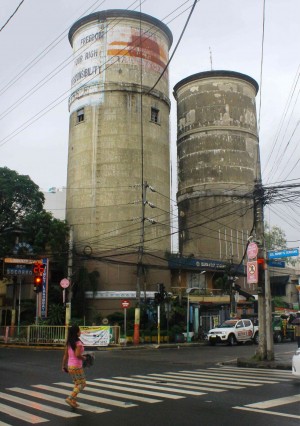
PREWAR RELICS The “twin towers” near Camp Aguinaldo have endured since the American colonial period. ERIKA SAULER
Towering over an area in Cubao, Quezon City, are two concrete water tanks built during the American colonial period, which officials of Barangay Socorro now want declared a historical landmark to ensure their preservation.
“The water tanks have been part of the history and landscape of the area. That’s why instead of saying ‘let’s go to the barangay hall,’ people here say ‘let’s go to the tanks,’” Barangay Councilor Ronald Espulgar said in an interview on Saturday.
The village council passed a resolution submitted to the city council last month requesting that the twin tanks be covered by the city government’s Heritage Development Program.
The resolution said that giving such importance to the structures “would instill awareness and appreciation of our historical roots.”
Espulgar said the water tanks were built by the Americans before World War II, approximately in the 1930s, and had withstood earthquakes and bombs, including those unleashed in the 1989 coup attempt against then President Cory Aquino. The tanks are located just outside the gate of Camp Aguinaldo on Bonny Serrano Avenue.
When the Americans left, the tanks and the surrounding property were turned over to the National Waterworks and Sewerage Authority (Nawasa), which is now the Metropolitan Waterworks and Sewerage System (MWSS).
Up to 15 stories tall
Another village councilor, Jaime Quiambao, recalled that shortly after the creation of Barangay Socorro in the 1960s, its barangay hall was allowed to be built within the MWSS property, largely through the efforts of then First Lady Imelda Marcos The site was then called Imelda Park.
The water tanks, which used to be the tallest structure and source of potable water in the Cubao area, became nonoperational in the late 1950s, Quiambao said.
One of the tanks actually has smaller dimensions as they were built about a year apart, Espulgar said. Presumably, the second tank was added to meet the water needs of the growing population. The officials estimated the tanks to be 12 to 15 stories tall.
Much of what residents know about the water tanks are based only on oral history. The village council expects that declaring it a historical landmark would lead to a deeper, documented research.
Village officials are hoping that the compound where the tanks stand—a prime property of about 1,000 square meters—would eventually be donated to the barangay.
Declaring it a historical landmark would not necessarily transfer ownership, Espulgar said, citing a similar undertaking in the Balara Filters Park, a property also owned by MWSS and revived in 2003 after decades of neglect.
Falling bits of concrete
The lower part of one of the towers has been converted into offices for village watchmen and for personnel under the barangay’s gender and development program. The other tower houses the barangay’s primary healthcare clinic. Behind the two towers is a covered basketball court and between them is a daycare center and the main barangay hall.
Espulgar noted that the tanks’ condition had been deteriorating, with the facade’s masonry flaking off and posing a danger to those below. Roofs were built around the compound as protection from the bits of concrete that fall from time to time.
He said one of the tanks sustained two holes caused by the exchange of fire in the 1989 coup attempt but the damage was later fixed.
In pursuing heritage development, the village resolution hopes to have the structures not only reinforced and refurbished but fittingly recognized for their endurance, possibly “with a logo and lights on top and a historical marker on the ground.”